Jon Cronshaw's Blog, page 5
June 19, 2025
Meet the King of Nobledark: Jon Cronshaw’s Author Manifesto
I didn’t mean to become the King of Nobledark.
Truly.
I was just minding my own business, poking around the edges of grimdark, whispering sweet nothings to hope, when I stumbled upon a dusty old crown lying in a forgotten corner of the fantasy genre.
No one was wearing it.
No one was even looking at it.
So, I picked it up, gave it a polish, and popped it on my head.
It fits rather well.
Naturally, I assumed someone would try to stop me. Perhaps a grimdark usurper, still drunk on blood and betrayal, lurching from the shadows, broadsword in hand, quoting Nietzsche and snarling about nihilism.
But alas, no.
Apparently, claiming the crown of Nobledark—that little corner of fantasy where honour still breathes (barely), where sacrifice means something, and where good people try to stay good in worlds that want them broken—isn’t high on anyone’s to-do list.
So here I am.
Jon Cronshaw. The King of Nobledark.
Now, I realise some of my fellow authors might feel tempted. You may think, “That crown would look rather fetching atop my morally complex, world-weary protagonist, actually.”
And I respect that.
But before you mount your literary siege engines, a word of warning: I’ve got wyverns. Highly trained ones. They don’t breathe fire—they just watch. Constantly. Silently. Judgementally. And if that doesn’t unsettle you, it really should.
I also carry a Ravenglass blade, forged with my own blood and tears. Beautiful, yes—but with the rather unfortunate side effect of burning its victims from the inside out. You won’t notice at first. You’ll think you’re fine. And then the screaming starts.
So if you, too, write stories where the world is cruel, but your characters dare to care anyway… then by all means, take up the mantle. Write nobledark. Spread the word. Let readers know that fantasy doesn’t have to choose between despair and delusion.
But the title?
That’s mine.
Unless, of course, you think you can take it.
(You can’t.)
Long live nobledark.
Long live the King.



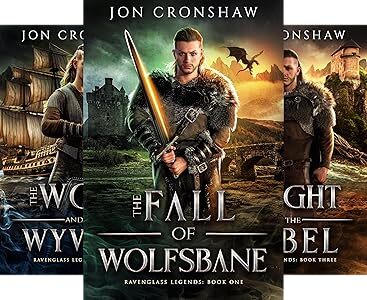
The post Meet the King of Nobledark: Jon Cronshaw’s Author Manifesto appeared first on Jon Cronshaw - The King of Nobledark.
June 17, 2025
Dawn vs Guild of Assassins: Which Series Comes First?
Which Series Should You Read First—Dawn of Assassins or Guild of Assassins?
If you’re looking to dive into the assassin-filled corners of the Ravenglass Universe, you might be wondering where to begin: Dawn of Assassins or Guild of Assassins?
The answer is simple—you can start with either.
Both series stand alone and can be read in any order.
It really comes down to what kind of story you want to read first.
Let’s break it down.
Release Order vs Timeline OrderIf you prefer to read books in the order they were published, start with Dawn of Assassins.
This was the first series released and introduces you to the world through the eyes of Fedor and Lev—street-smart thieves who find themselves dragged into a world of blades and blood by the brutal assassin Soren.
If you’d rather follow the story in chronological order, begin with Guild of Assassins.
This series explores Soren’s tragic backstory—how a sculptor’s apprentice seeking justice for his father’s murder slowly loses himself in the shadows of the Guild.
Understand Soren Before or After?This is the heart of the choice.
If you read Guild of Assassins first, you’ll understand Soren before you fear him. You’ll follow his descent from idealistic boy to ruthless killer—and by the time he appears as the master assassin in Dawn, you’ll see just how far he’s fallen.If you start with Dawn of Assassins, you’ll meet Soren at his coldest. He’s the brutal, calculating mentor who gives Fedor and Lev no choice but to become killers. Then, Guild becomes a powerful look into how he ended up that way.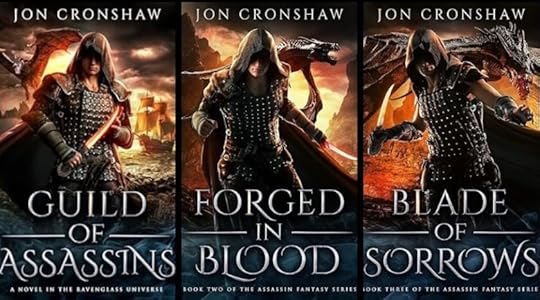 Tone and Style
Tone and StyleEach series has its own distinct flavour:
Dawn of Assassins is fast-paced, banter-filled, and leans into roguish fantasy with cons, capers, and reluctant heroes. At its core, it’s a story of found family, friendship, and resisting the darkness of the world.Guild of Assassins is darker and more introspective. It’s a psychological grimdark tale about the cost of revenge, the erosion of morality, and the slow transformation of a young man into something he once despised. Final VerdictWant something sharp, punchy, with streetwise thieves and reluctant heroes? Start with Dawn of Assassins.Want something darker, more emotional, and morally complex? Go with
Guild of Assassins
.Want to follow the story as it happened in the world? Begin with Guild.Want to read the series in the order they were published? Begin with Dawn.
Final VerdictWant something sharp, punchy, with streetwise thieves and reluctant heroes? Start with Dawn of Assassins.Want something darker, more emotional, and morally complex? Go with
Guild of Assassins
.Want to follow the story as it happened in the world? Begin with Guild.Want to read the series in the order they were published? Begin with Dawn.Whichever path you take, both series lead you deep into the shadows of the Ravenglass Universe—and neither promises an easy way out.
 Get Guild Assassin free at joncronshaw.com/guildassassin.
Get Guild Assassin free at joncronshaw.com/guildassassin.
The post Dawn vs Guild of Assassins: Which Series Comes First? appeared first on Jon Cronshaw.
June 16, 2025
Essential Gritty Military Sci-Fi Novels You Need to Read
If you enjoy your science fiction with battle-scarred soldiers, psychological wounds, and moral compromises, military sci-fi might already be your go-to genre.
But not all entries are created equal.
The best gritty military sci-fi doesn’t just fire lasers—it hits you in the gut.
These ten standout novels go beyond the pew-pew and drop you into brutal conflicts, internal crises, and worlds where survival comes at a cost.
Outbound Recon by Logan Shields
A standout of the modern military sci-fi scene, Outbound Recon delivers everything fans of gritty space thrillers want.
Jack Rourke is the perfect soldier—until he’s sent to kill civilians.
When memories that aren’t his begin to surface, he questions the mission, the system, and himself.
A psychological gut-punch wrapped in classified missions and high-tech shadow ops.
If you like conspiracies, unreliable memory, and rogue soldiers flipping the script, start here.
Recommended for readers who enjoy: secret space programmes, identity crises, morally grey heroes.
get your copy.Glory Boy by Rick Partlow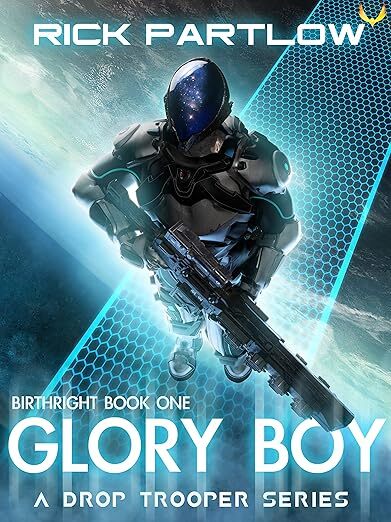
Caleb Mitchell walks away from a peaceful upbringing to join the fight against an alien empire.
But war doesn’t wait for permission.
Caught in a brutal ambush, declared dead, and reborn as a covert supersoldier, Cal must decide what’s left of his humanity—and whether to fight for the world that rejected him.
A solid blend of character-driven military action and sci-fi stakes.
Recommended for readers who enjoy: power armour, betrayal, and finding purpose through fire.
get your copy.Renegade by Joel Shepherd
Court-martialled. Framed. Hunted.
Lieutenant Commander Erik Debogande didn’t sign up for any of that.
After his captain is killed and the fleet turns on him, Erik escapes aboard the UFS Phoenix, seeking the truth.
What he uncovers will shake the galaxy.
Renegade mixes fleet-scale action with political intrigue and betrayal on an epic scale.
Recommended for readers who enjoy: conspiracies, space opera with teeth, and relentless pacing.
get your copy.Terms of Enlistment by Marko Kloos
Andrew Grayson signs up to escape the slums—real food, decent housing, and maybe a way off Earth.
But what he finds in the military is more bureaucracy, more violence, and a war machine that doesn’t care who it chews up.
A sharp, character-focused entry in the Frontlines series that pulls no punches.
Recommended for readers who enjoy: Heinlein with grit, grounded future warfare, class conflict.
get your copy.Starfist: Lazarus Rising by David Sherman
The 34th FIST marines just won their toughest battle yet—but the aftermath is worse.
A new regime rises, and survivors with wiped memories struggle to piece together their identities.
One will uncover a truth that threatens everything.
This one leans into raw combat and existential fallout.
Recommended for readers who enjoy: military brotherhood, lost identity, and high-stakes recovery missions.
get your copy.Deep Range by Aaron M. Lancaster
A working-class captain, a corporate favour, and a ticking secret.
The Havelock crew take a routine job in the Deep Range—but find themselves holding tech that could ignite war.
Lancaster’s story captures the claustrophobia of deep space and the pressure of grey-area decisions.
Recommended for readers who enjoy: space hauliers, working-class sci-fi, and slow-burn intensity.
get your copy.Sten by Chris Bunch and Allan Cole
Raised on the hellhole factory world of Vulcan, Sten’s story is one of rage, rebellion, and survival.
A classic of the genre, this is old-school military SF with a working-class edge, kicking off a long-running series.
Fast-paced, sharp-tongued, and never short on bullets.
Recommended for readers who enjoy: rebellion from the gutter, industrial dystopias, no-nonsense protagonists.
get your copy.Assassination Protocol by Andy Peloquin
Nolan Garrett is a government-sanctioned killer in a cybernetic suit—until his past comes crashing through his door.
With a cartel on his back and a vulnerable ex-soldier in his care, Nolan must walk the line between duty and decency.
Cybernetics, corruption, and brutal shootouts make this an addictive read.
Recommended for readers who enjoy: assassins with hearts, cyberpunk tech, emotional stakes.
get your copy.Dauntless by Jack Campbell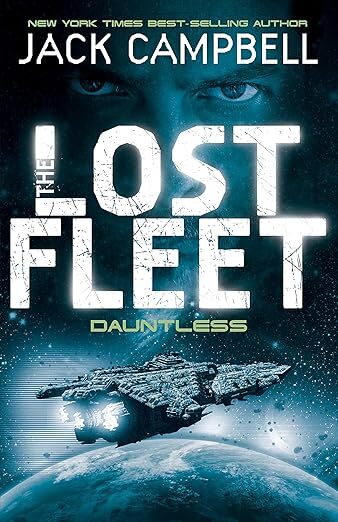
Captain Geary wakes from hibernation to find himself a legend—and the only hope for a fleet stranded in enemy territory.
He must lead them home, all while questioning his own myth and the realities of command.
This kicks off The Lost Fleet, a masterclass in space warfare, tactics, and leadership under pressure.
Recommended for readers who enjoy: space battles, military hierarchy, reluctant heroes.
get your copy.Gritty military sci-fi doesn’t just tell stories of war—it asks what war does to the people who fight it.
These ten novels stand out for their raw intensity, moral complexity, and unforgettable characters.
Whether you’re new to the genre or neck-deep in tactical thrillers, each of these books has something worth bleeding for.
Got another title that deserves a mention? Let me know in the comments—or load up your reader and get ready for war.
Note: This article includes affiliate links.
The post Essential Gritty Military Sci-Fi Novels You Need to Read appeared first on Jon Cronshaw.
An Examination and Refutation of the So-Called “Guild of Assassins”
By Archibald F. Chistlethwaite, Fellow of the Collegium Historica et Jurisprudence, Nordturm.
It is with reluctant quill that I address the increasingly widespread and patently ludicrous assertion that a clandestine organisation known colloquially (and melodramatically) as the “Guild of Assassins” operates with impunity across the civilised territories of Wiete and beyond. One is tempted to dismiss such nonsense outright, consigning it to the same intellectual rubbish-heap as the flat world theory or the practice of communing with ghosts via tapping tables. And yet, this absurdity has gathered such momentum among the lower classes and—lamentably—some among the fashionable intelligentsia, that a sober rebuttal becomes, alas, necessary.
Let us be clear: assassins do exist. No rational person denies that individuals of violent disposition and mercenary inclination will, from time to time, accept coin in exchange for the illicit termination of a fellow human being. Just as highwaymen exist without forming an International League of Robbers, and drunkards stumble without enrolling in a Society of Inebriates, so too do murderers ply their loathsome trade without recourse to formal membership cards or annual banquets.
To suggest that there exists a structured guild—with rules, training, administration, and one presumes, branded stationery—is not merely an error; it is a deliberate assault on reason, order, and good taste. That a body politic such as our own would tolerate, much less overlook, the presence of a professionalised murder syndicate operating under a recognisable name is an insult to both our institutions and our intelligence.
The Origins of the MythThe roots of this fabrication lie, predictably, in the fevered imaginations of penny dreadful authors and the credulous minds of those who consume them. Tales of shadowy cabals, secret handshakes, and cryptic initiation rites have always proven titillating to the under-educated and over-stimulated. The myth of the Guild offers the delicious allure of conspiracy without the burden of evidence.
One cannot ignore the influence of historical romance. The romanticisation of the assassin—the blade in the night, the whispered name, the poetic justice delivered by unseen hands—has always appealed to the idle minds of salon philosophers and adolescent scribblers. Combine this with the tragic decline of classical education, and it is little wonder we are besieged with fancies of assassin training schools, blood-forged contracts, and honour codes among murderers. Such narratives bear as much relation to the truth as does a child’s drawing to the architecture of the Palace of Welttor.
Absurdities Inherent in the Guild TheoryLet us apply the scalpel of logic to this carbuncle of misinformation.
1. Organisational Infrastructure: We are to believe that this so-called Guild maintains a network of recruitment, instruction, assignment, and payment across the known territories without detection. Are we to imagine offices in each major city? Regular payroll disbursements? Minutes from quarterly meetings? One envisions a secretary scribbling, “Item 4: increase in poisoning demand; committee to investigate seasonal variance.”
2. Recruitment: Whence come these killers? Are they poached from sculptors’ studios? Fished from fishing boats? Who interviews them? Is there a probationary period? Do they begin with kittens before progressing to barons? The logistics are laughable.
3. Training: Much is made in the more salacious pamphlets of a rigorous training regimen undertaken by Guild recruits. How, pray, does one conduct swordsmanship and stealth lessons without arousing suspicion? Do the Guild’s headquarters reside in a well-lit gymnasium? And who trains the trainers? Is there a credentialing body?
4. Payment and Client Relations: How are clients to locate the Guild? Are there brochures? A discreet office with a placard reading Deaths Arranged, Discretion Ensured? It strains credulity to its snapping point. Are payments rendered in coin, promissory note, or perhaps ravenglass? Does the Guild offer receipts?
5. Moral Code: The notion that a collection of cut-throats, brigands, and poisoners might adhere to a strict code of conduct is as credible as suggesting foxes maintain a union for the humane treatment of hens. Honour among killers is a concept found in the plays of Edric Morden—and nowhere else.
Convenient ConspiraciesProponents of the Guild theory, when pressed for evidence, will inevitably fall back upon the oldest rhetorical refuge of the liar: that the very absence of proof is, itself, proof. “You see,” they claim, “the Guild is so effective, so utterly secret, that it leaves no trace!” This is the logic of the madhouse.
By this metric, one might also prove the existence of invisible dragons in the Crown’s privy. The absence of their droppings, after all, merely confirms their tidy habits.
A popular variant of this fallacy is the assertion that Guild members operate within society itself: embedded in merchant houses, constabularies, even the Magistracy. Such a claim not only libels the brave men and women who serve our public institutions but also renders the Guild unfalsifiable—a sure hallmark of bunkum.
The Economic ImpossibilityConsider the cost. To fund the infrastructure of a continent-spanning assassin collective would require a treasury rivalled only by that of Ostreich. The training, housing, outfitting, and payment of hundreds of silent killers is not a modest undertaking. We are to believe this expenditure is met by sporadic commissions from brothel-owners and jealous siblings? Nonsense.
Moreover, an oversupply of assassins would undercut their own market. One cannot both be rare and ubiquitous. If killing-for-hire were so commonplace, the value of a life would plummet, and every petty squabble would end in bloodshed. We would be swimming in corpses, not idling in cafes.
Eyewitness Accounts: Or, the Infallibility of RumourTime and again, one is confronted with the testimony of some trembling ostler or besotted sailor who claims to have seen a Guild assassin in the act. These accounts tend to share certain features: darkness, distance, alcohol, and embellishment. As any trained observer knows, the human memory is a carnival mirror: entertaining, but not to be trusted.
Even more damning is the fact that such sightings invariably occur after the event. Never does one hear of a Guild assassin being interrupted, captured, or identified in advance. They are always glimpsed slipping away, vanishing into crowds, or retreating into the fog. Their passage is marked only by the sudden death of some minor noble or an inconvenient whistle-blower.
Might I suggest that these assassins are as much constructs of hindsight as of fiction? It is far easier to blame a mythical killer than to accept the all-too-real presence of vendettas, political silencing, or lovers’ spats gone awry.
The Cultural Role of the Guild MythSo why, if the Guild does not exist, does the myth persist? The answer, like most answers worth anything, is psychological. The Guild serves a narrative function. It allows the populace to project its fear of chaos, of death, of unreasoning malice, onto a single, comprehensible symbol.
Better to believe in a dark, elegant guild than to confront the chaos of random violence. Better to imagine trained hands behind the blade than to accept the banality of murder. The Guild gives meaning to atrocity. That is its sole function.
A Final Word on Sanity and SovereigntyAs a scholar, a gentleman, and a loyal subject of the Heptarchy, I must affirm in the strongest possible terms that the very idea of an organised Guild of Assassins is both fantastical and corrosive. It undermines trust in our institutions, encourages paranoia, and distracts from the real work of maintaining law and order.
We must be vigilant not against mythical guilds, but against the human tendency to seek monsters in shadows rather than face the truths before us.
In conclusion, the Guild of Assassins is a fiction. A lie. A childish story told to frighten dull minds and entertain dilettantes.
That is the official position.
Let no further ink be wasted on the matter.
Editor’s Note: Archibald Chistlethwaite was found dead three months after publishing this entry, his throat expertly slit in his study. The local constable attributed the incident to a burglary gone wrong. No suspects were ever apprehended. The Encyclopaedia has elected to retain his article in full, for historical interest only.

The post An Examination and Refutation of the So-Called “Guild of Assassins” appeared first on Jon Cronshaw.
June 13, 2025
🐉 Draft Progress, Kate Bush, and Hoping for Healing | Author Diary – June 13, 2025📚🎶
This week, I’ve hit the 60 percent mark on the draft of The Prince and the Fool (Ravenglass Legends, Book 4).
The story is moving steadily, and I’m excited to see it coming together.
I’ve also been reading the 33 1/3 book on Kate Bush’s Hounds of Love—a fascinating deep dive into one of my all-time favourite albums.
And I’ve finally started watching House of Cards on Netflix—dark, sharp, and brilliantly acted.
I’m still dealing with a bad back, which has been slowing me down. I’m really hoping it improves soon, especially with Nine Inch Nails coming up next week—fingers crossed I’ll be well enough to go!
The post 🐉 Draft Progress, Kate Bush, and Hoping for Healing | Author Diary – June 13, 2025📚🎶 appeared first on Jon Cronshaw.
June 9, 2025
On the History and Hidden Influence of the Guardians
As compiled by Prof. Aldus Verrick, Imperial Chair of Esoteric Histories, Archivum Arcanum, Ostreich High Collegium
INTRODUCTION
Though dismissed by modern scholars as a secretive footnote in the broader annals of imperial conquest, the Guardians have, in truth, shaped the course of history in ways few dare to admit and fewer yet comprehend. Across empires, ages, and continents, they have appeared not as conquerors, nor prophets, but as those who whisper to both.
This paper endeavours to document what little verifiable history remains of the organisation known collectively as the Guardians, drawing upon fractured accounts, redacted imperial records, forbidden texts, and the few surviving oral testimonies of former members (now deceased). Though the Guardians are by design elusive, the threads they leave are woven through the rise and fall of dynasties, the shaping of philosophical systems, and—most crucially—the stewardship of Ravenglass.
ORIGINS AND MYTHIC FOUNDATIONS
The earliest references to the Guardians predate reliable written history. Petroglyphs found in the ruins of Tsarrik, etched into the walls of what may have once been an observatory or temple, depict robed figures holding a raven-black shard to the sky. Beneath the figures are symbols commonly interpreted to mean balance or equal measure.
Later, in the Song-Cycles of the Wandering Seers, the Guardians are alluded to as “those who move between the lines,” guiding tribes away from natural disasters, kings from hubris, and mages from consuming themselves in fire. Such figures are not named, but share recurring characteristics: detachment, intervention at pivotal moments, and reverence for the unknown.
These early accounts suggest the Guardians were never a centralised order but a philosophical movement—perhaps even a reaction—to unchecked magical, political, or divine excess. Their creed: To seek truth. To bring balance. To bring order to chaos, and chaos to order.
CONSOLIDATION AND EXPANSION
While no single founding event can be confirmed, it is during the Late Meridian Era that evidence emerges of the Guardians acting with deliberate coordination. Letters preserved in the archives of Mareth’s Cathedral mention a group calling themselves Keepers of Equilibrium, warning against an early attempt to mass-forge Ravenglass weapons by the kings of Kallathen. The warnings, unheeded, coincided with the Kallathen Collapse and the decade-long War of Smoke.
By the Age of the First Expansion (3E.012–3E.124), the Guardians were well known in court records—not as open agents, but as a conspiracy. Under Emperor Kurgan the Dragon, a former wyvern general turned autocrat, the Guardians were declared enemies of the state. Kurgan feared their influence, particularly their presence within temple hierarchies, alchemical guilds, and even among the ranks of his own advisors.
The result was the infamous Purge of the Temples, during which thousands were executed or vanished. Entire monastic orders disappeared. Shrines were razed. Many believed the Guardians destroyed. Kurgan himself ordered the execution of his own brother, citing “Guardian sympathies” and accusing him of attempting to seed Ravenglass into the imperial court as a conduit of rebellion.
This was, however, a miscalculation. Though damaged, the Guardians did not die. They splintered, hid, and—according to later records—began to adapt.
REFORMATION DURING THE CONQUEST OF WIETE
It is during the Empire’s conquest of Wiete—a mountainous and politically fragmented region known for stubborn autonomy and folk sorcery—that the Guardians re-emerge. At first, they were dismissed as rebel agitators. Yet the resistance was too coordinated. Imperial war records from the campaign note repeated intelligence failures, unanticipated counter-strikes, and near-prophetic knowledge of troop movements.
Documents seized from a captured courier mention Guardian ciphers and references to internal factions: Watchers, Keepers, Seekers, and the rarely mentioned Shadows. It appears the reformed Guardians no longer acted as a unified order, but as seven decentralised circles, each maintaining its own methods and priorities while adhering to the core doctrine of balance.
The conquest ended in imperial victory—but not without cost. Wiete remains the only province where the Emperor’s appointed governor refused to expunge all Guardian presence, citing “regional stabilisation”. Whether this was born of pragmatism or quiet allegiance remains unconfirmed.
THE CIVIL FRACTURE
Following the conquest, the Guardians underwent what is now referred to as the Civil Fracture. Correspondence preserved in the Red Folios of Ferrick’s Tower suggests a deep philosophical split. Some believed the Guardians should continue as hidden arbiters—”shepherds from the shadows.” Others, particularly among the Seekers and Shadows, advocated direct intervention, believing the world too diseased to heal slowly.
The resulting schism turned bloody. Entire cells were purged by rival factions. Ravenglass artefacts were destroyed, hidden, or claimed. From this era come the whispers of the Null Forge, a device said to erase a Guardian’s bond permanently. Whether it existed or was a metaphorical tool of shame is unknown.
The Guardians never recovered full unity. From that point on, they would exist as competing interpretations of the same philosophy.
PHILOSOPHY AND FUNCTION
Despite their internal conflicts, all Guardians hold to three tenets:
Seek Truth – The Guardians reject dogma, favouring direct observation, evidence, and the pursuit of deeper understanding—even at great cost.Maintain Balance – Whether between nations, natural forces, or ideologies, their goal is to preserve equilibrium. This has led to both support for and subversion of regimes, depending on circumstance.Disrupt Pattern – When systems become too rigid, the Guardians introduce chaos. When too chaotic, they bring order. This dialectic action is central to their interventions.They do not worship, but some treat Ravenglass itself as a sacred substance, believing it to be a remnant of divine creation, or the residue of a higher consciousness. Guardian initiates undergo a Binding Rite involving exposure to the mushroom Mantari—often resulting in prophetic dreams, temporary madness, or (in rare cases) death.
GLOBAL PRESENCE
Though born in the heart of the Ostreich Empire, the Guardians have since spread—operating covertly in the glass bazaars of Sieshin, among the scribe-tribes of Yao, and even within Molotok’s frozen academies. Local governments alternate between denial and paranoia, depending on how recently their leadership has been undermined.
Of particular interest is the Archive rumoured to exist beneath the old library on Gottsisle, believed by some to contain the last complete repository of Ravenglass knowledge—including forging techniques lost since the Kurganic purge. Entry, if it exists, has never been confirmed.
CONCLUSION
To study the Guardians is to chase shadows cast by deeper fire. They are not heroes. They are not villains. They are agents of intent, wielding Ravenglass not for conquest, but for correction.
That the Empire has failed to destroy them after centuries of effort is perhaps the greatest evidence of their necessity.
Should one encounter a Guardian—and know them for what they are—it is wisest not to ask their allegiance, but their purpose. And hope that purpose does not require your undoing.
Filed for restricted circulation only.
Copying, reproduction, or unauthorised reading is a punishable offence under Imperial Decree 3E.722.b.
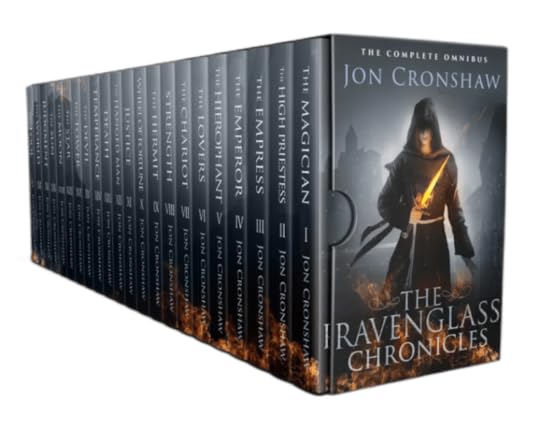
The post On the History and Hidden Influence of the Guardians appeared first on Jon Cronshaw.
June 6, 2025
🐉 Back to Writing, Midpoint Milestone & A Bit of Back Pain | Author Diary – June 6, 2025 📚🦌
After taking last week off, I’m back at the writing desk and making great progress on The Prince and the Fool (Ravenglass Legends, Book 4).
I’ve just hit the mid-point of the book—and the series itself!
I’ll be sharing unedited chapters on Patreon over the next few weeks for those following along early.
This week, I also chat about reading Homecoming by Robin Hobb—a beautifully written book as always—and watching Baby Reindeer on Netflix, a dark but excellent drama that’s definitely stayed with me.
On a less fun note, I’ve been nursing a bad back, which means I’ve had to miss out on seeing one of my favourite bands, James.
Hoping to be back on my feet properly soon!
The post 🐉 Back to Writing, Midpoint Milestone & A Bit of Back Pain | Author Diary – June 6, 2025 📚🦌 appeared first on Jon Cronshaw.
June 5, 2025
The Order of the Guardians: A Complete Guide to the Seven-Path System in the Ravenglass Universe
The Guardians stand as one of the most intricate and morally layered institutions in the Ravenglass Universe.
Formed in response to centuries of war, oppression, and cultural devastation, the Guardians emerged from the ruins of broken systems with a radical new purpose.
They are neither a military force nor a religious sect, but a decentralised order bound by a shared commitment to truth, balance, and service.
Operating in secrecy and often in tension with ruling powers, the Guardians represent a unique answer to the question of how to do good in a world shaped by conquest.
What Are the Guardians? Understanding Their Core MissionThe Guardians exist outside the structures of empire, monarchy, and temple.
They are guided by three core principles that define their mission across the Ravenglass Universe.
Balance Over Dominance: The Guardians resist all forms of absolute control.
They aim not to topple governments or seize power, but to maintain equilibrium by ensuring no single ideology, empire, or institution becomes dominant.
Truth Over Convenience: In a world where truth is often manipulated or erased, the Guardians preserve facts that others would prefer forgotten.
They protect knowledge, maintain hidden archives, and guard against historical revisionism.
Service Over Self: Guardians renounce personal ambition and political allegiance.
Their loyalty lies only with those who cannot defend themselves, with the oppressed, the forgotten, and the silenced.
The Seven Paths: Specialisation Within UnityThe Order recognises that one solution cannot address every problem.
To meet the demands of a complex world, the Guardians operate through seven specialised paths, each with its own tools, philosophy, and domain.
The Watchers: Silent Observers of TruthWatchers are the Order’s unseen eyes, observing without interference or personal bias.
They track power, corruption, and injustice over the long term.
Primary Role: Observation, surveillance, intelligence gathering.
Methods: Deep cover, cultural immersion, network cultivation.
Weapons: Concealed ravenglass daggers for discretion and defence.
Leadership: Klug, a wyvern whose longevity brings depth to strategic insight.
Watchers are not agents of sabotage or espionage.
They simply witness—providing critical knowledge to help the other paths act effectively.
The Keepers: Guardians of Memory and KnowledgeKeepers preserve what must not be lost.
They carry the memory of civilisations and ideas across generations.
Primary Role: Archival preservation, education, cultural safeguarding.
Methods: Library maintenance, translation, schooling.
Weapons: Engraved ravenglass staves used more for ceremony than battle.
Leadership: Friderich Ostehild, a scholar dedicated to resisting cultural erasure.
Keepers ensure that wisdom is not swept away by conquest or dogma.
They teach the next generation, protect endangered traditions, and oppose historical amnesia.
The Apothecaries: Healers of Body and SoulApothecaries walk the line between restoration and necessary harm.
They understand that health extends beyond the individual to entire communities.
Primary Role: Healing, care, targeted elimination of systemic threats.
Methods: Traditional medicine, trauma care, precise poisoning.
Weapons: Ravenglass instruments for surgical use or discreet action.
Leadership: Amalia Thornwick, a healer who recognises when silence kills.
Apothecaries may cure a village of plague one day, then poison the governor who let the disease spread the next.
Their work is rooted in justice as much as compassion.
The Inquisitors: Seekers of Uncomfortable TruthInquisitors specialise in uncomfortable answers.
They combine logic, philosophy, and interrogation to uncover hidden realities.
Primary Role: Investigation, truth-seeking, mediation.
Methods: Discourse, psychological probing, formal questioning.
Weapons: Ravenglass maces as symbols of intellectual authority.
Leadership: Peterade, a former jester turned philosopher-interrogator.
Inquisitors don’t punish dissent.
They examine it, looking for causes, contradictions, and consequences in pursuit of clarity rather than conformity.
The Sentinels: Shields of the InnocentSentinels are defenders, not conquerors.
They stand between the vulnerable and the violent.
Primary Role: Defence, sanctuary, civilian protection.
Methods: Guarding safehouses, protecting convoys, battlefield restraint.
Weapons: Ravenglass longswords, hammers, and lances.
Leadership: Virium, a seasoned defender who values strength through restraint.
Sentinels offer shelter in times of crisis.
They enforce boundaries not through conquest but through guardianship.
The Seekers: Explorers of Hidden TruthSeekers extend the Guardians’ reach to the margins of the world.
They work where imperial maps fail and foreign cultures are dismissed.
Primary Role: Exploration, diplomacy, cultural preservation.
Methods: Long-term immersion, translation, artifact recovery.
Weapons: Personalised ravenglass tools adapted to local environments.
Leadership: Vacant since Maja assumed broader responsibilities.
Seekers build bridges between peoples and histories.
They recover what empires would bury and learn what rulers refuse to understand.
The Shadows: The Hidden HandShadows do what others cannot.
Their actions are unrecorded, their faces unknown.
Primary Role: Assassination, infiltration, sabotage.
Methods: Identity suppression, covert manoeuvres, final recourse.
Weapons: Silent ravenglass tools designed for stealth and certainty.
Leadership: Witz, a wyvern whose memories map centuries of darkness.
When diplomacy and healing fail, when reform becomes impossible, the Shadows act so that others may still walk in the light.
Leadership Structure: Preventing the Corruption of PowerThe Guardians structure their leadership to avoid the pitfalls that brought down previous institutions.
No one is above scrutiny.
The Council of MeistersEach of the seven paths is led by a Meister with full authority in their domain.
Together, the Meisters form a council where all decisions of consequence must be unanimous.
This ensures accountability and prevents dominance by any single ideology or personality.
The Arch MeisterThe Arch Meister serves not as a ruler but a unifier.
This position requires deep familiarity with all seven paths and a commitment to fairness and collective action.
Current Arch Meister: Maja Wolfsbane, chosen not for power, but for her ability to balance vision with consequence.
If the council agrees unanimously, the Arch Meister can be removed, reinforcing the primacy of collective will over personal ambition.
The Guardians’ Place in the Ravenglass UniverseThe Guardians appear across multiple series in the Ravenglass Universe, acting as a moral undercurrent beneath shifting political tides.
They are not a ruling faction.
They are a force for restoration, truth, and balance operating across kingdoms, continents, and centuries.
Where others seek control, the Guardians offer resistance to corruption, guidance to the lost, and memory to the forgotten.
Why the Guardians Matter: Relevance Beyond FantasyThe Guardians model an institution built on restraint, nuance, and commitment to principle.
They embrace complexity where others demand loyalty.
Their structure—diverse, decentralised, yet unified—suggests how real change might endure in the face of tyranny.
They show that heroism doesn’t always wear a crown or wield a blade.
Sometimes, it teaches a child to read, or watches from the shadows, or simply says no when silence is easier.
The Guardians ask what power is for—and answer with service.
Join the community.
The post The Order of the Guardians: A Complete Guide to the Seven-Path System in the Ravenglass Universe appeared first on Jon Cronshaw.
June 3, 2025
Grit, Steel, and Secrets: 5 Fantasy Novels About Assassins
From the shadows of court intrigue to blood-stained alleyways, assassin fantasy remains one of the most gripping and morally complex subgenres in fantasy fiction.
These are stories where characters walk the knife’s edge between justice and murder, loyalty and betrayal.
Whether you’re drawn to heart-wrenching emotional arcs, secret guilds, or cold-blooded killers with a code, here are five assassin fantasy novels you absolutely need to read.
1. The Way of Shadows by Brent Weeks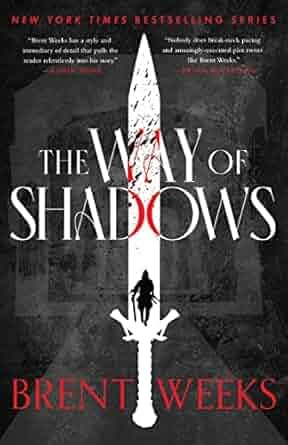
Brent Weeks’ The Way of Shadows is a modern classic of the assassin fantasy genre. It follows Azoth, a street urchin who becomes apprentice to Durzo Blint, the most feared “wetboy” (an enhanced assassin) in the city of Cenaria.
Fast-paced, gritty, and emotionally charged, this is a story about transformation, sacrifice, and the cost of power. With brutal fight scenes and a twist-laden plot, The Way of Shadows delivers on both character and action.
Why read it?
It’s the perfect entry point for readers who want cinematic storytelling, high stakes, and a protagonist caught between humanity and the job.
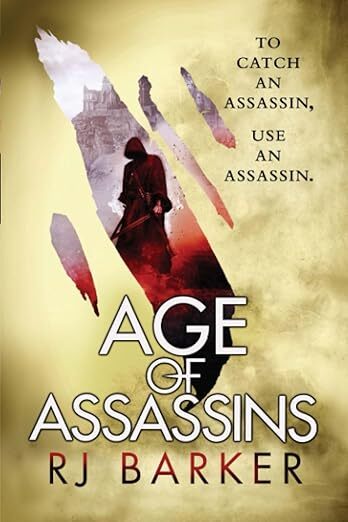
In Age of Assassins, RJ Barker gives us a refreshingly intimate tale with a deeply relatable lead. The story centres on Girton Club-Foot, a disabled assassin-in-training tasked with protecting a prince from assassination—by pretending to be a noble.
Blending murder mystery, political scheming, and heartfelt friendship, Barker crafts a world where loyalty is as deadly as any blade.
Why read it?
It’s smart, surprisingly emotional, and offers a new perspective on the genre with strong disability representation and elegant prose.

In Darkblade, Andy Peloquin introduces The Hunter, a ruthless assassin cursed with immortality and plagued by forgotten sins. Stripped of memories and hunted by monstrous enemies, The Hunter must uncover his past while wielding a sentient blade that thirsts for blood.
This is a fast-paced, morally complex series filled with bloody combat, internal torment, and dark magic. As The Hunter tries to make sense of who he was—and who he might become—he must decide whether redemption is worth killing for.
Why read it?
With its anti-hero protagonist, unrelenting tension, and a blend of action and introspection, Darkblade is a gripping assassin fantasy perfect for fans of The Witcher and The First Law.
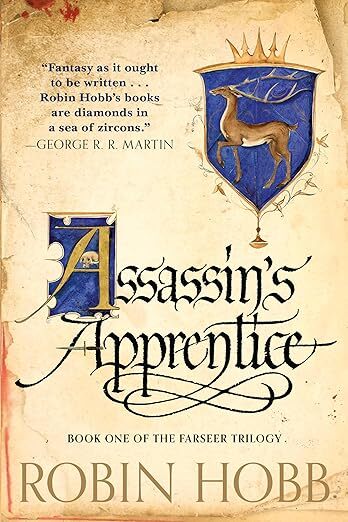
Robin Hobb’s Assassin’s Apprentice redefined what assassin fantasy could be. The story follows FitzChivalry Farseer, a royal bastard trained as a court assassin. But this is no ordinary training montage—Fitz’s journey is filled with isolation, emotional trauma, and quiet resilience.
With her signature slow-burn character work and psychological insight, Hobb builds a rich, painful story that stays with you long after the final page.
Why read it?
It’s one of the most emotionally powerful fantasy novels ever written, and essential reading for anyone who wants their assassins complex, broken, and unforgettable.
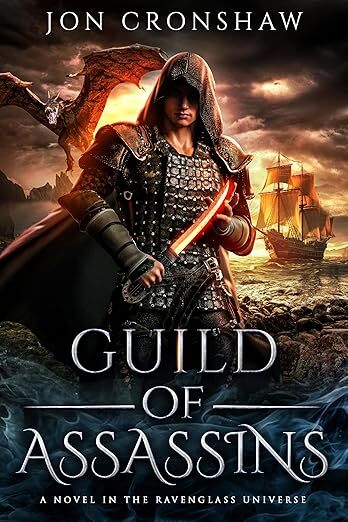
In Guild of Assassins, Jon Cronshaw introduces Soren, a sculptor’s apprentice whose life is shattered when his father is murdered by a man with a scar and a smile. When the law fails him, Soren follows the trail into the shadows—and discovers a secret society of killers-for-hire.
What begins as a quest for justice becomes a descent into something far darker. With rich characterisation, grounded worldbuilding, and a slow-burn emotional arc, Guild of Assassins is ideal for fans of Hobb, Weeks, and grimdark stories with heart.
Why read it?
It’s an emotionally charged, character-driven fantasy that blends gritty realism with moral tension, ideal for readers who enjoy low-magic worlds and slow transformations.
Assassin fantasy continues to evolve, offering stories that explore not just how to kill—but why. Each of these books brings something unique to the table, whether it’s the pulse-pounding action of Brent Weeks or the psychological weight of Jon Cronshaw’s Guild of Assassins.
If you’re ready to step into the shadows, these novels are the perfect place to begin.
Start your journey into the shadows now.
 Guild of Assassins is available on Amazon Kindle and paperback
Guild of Assassins is available on Amazon Kindle and paperback
The post Grit, Steel, and Secrets: 5 Fantasy Novels About Assassins appeared first on Jon Cronshaw.
June 2, 2025
Behind the Cover: The Ravenglass Throne
When it came to creating a cover for The Ravenglass Throne, I knew I needed something that would truly capture the tone and scale of the story—royalty, rebellion, and wyverns.
The result? A breathtaking cover that exceeded all expectations, thanks to the incredible work of Covers by Christian.
Christian’s approach combines expertly chosen stock photography with layered digital painting to bring the Ravenglass Universe to life.
Irmin in her armour, Berthold at her side, the Imperial Palace in the background—it’s all there in a single, striking image.
Every element on the cover was selected with care: the lighting, the pose, even the subtle background details that hint at deeper story threads.
The final image isn’t just beautiful—it feels like the book.
Honestly, how great does it look?
If you’re an author looking for top-tier fantasy covers that make readers stop scrolling and start clicking, I can’t recommend Covers by Christian enough.
The Ravenglass Throne is available now—come for the cover, stay for the story.
The post Behind the Cover: The Ravenglass Throne appeared first on Jon Cronshaw.



